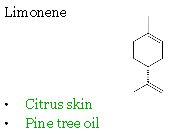Citrus skins:
- lime
- lemon
- orange
- grapefruit
Citrus contains:
- limonene
- citric acid
Tumors:
- Protect their outer membranes
- with LPS "Lipo-Poly-Sacarrhides"
- fatty sugars
- these sugars are strong and resistant
- Germs also coat in fatty-sugar
- White Blood Cells cannot penetrate LPS
- Limolene destroys LPS
- Then the tumor is vulnerable
- LPS is key in drug resistent tumors and bacteria
- LPS contains germ toxins that harm our WBC's.
Lipopolysaccharide - LPS
- germ warfare
- viruses coated in 'oily-sugar'
- trigger of inflammation
- found in intestinal bacteria
- tumors
- often treated with steroids which target oils
- Paracetamol / Tylenol target oils to stop fever
--- In this reported study:
- Limonene is anti-tumor, anti-cancer
- Did not show any toxicity to cells
- Works by breaking up the LPS
- Reduces inflammations
- quantity is important
- dose-dependent
- the more the better
Kills germs
---
J Oleo Sci.
2010;59(8):415-21.
doi: 10.5650/jos.59.415.Limonene Suppresses Lipopolysaccharide-Induced Production of Nitric Oxide, Prostaglandin E2, and Pro-Inflammatory Cytokines in RAW 264.7 Macrophages
Weon-Jong Yoon 1 , Nam Ho Lee, Chang-Gu Hyun
PMID: 20625233
DOI: 10.5650/jos.59.415
Abstract
The monoterpene D-limonene and its metabolites have been shown to exert chemopreventive and chemotherapeutic effects against different tumours in animal models and clinical trials. However, it is unknown whether these compounds modulate the inflammatory response in RAW 264.7 macrophage cells. The present study was therefore designed to elucidate the pharmacological and biological effects of D-limonene on the production of pro-inflammatory cytokines and inflammatory mediators in macrophages. The results indicate that D-limonene is an effective inhibitor of lipopolysaccharide (LPS)-induced NO and prostaglandin E(2) production in RAW 264.7 cells. These inhibitory effects of D-limonene included dose-dependent decreases in the expression of iNOS and COX-2 proteins. To evaluate the inhibitory effects of D-limonene on other cytokines, we also measured TNF-alpha, IL-1beta, and IL-6 levels in the cell supernatants of LPS-stimulated RAW 264.7 macrophages by enzyme-linked immunosorbent assay. In these assays, D-limonene decreased the expression of TNF-alpha, IL-1beta, and IL-6 in a dose-dependent manner. To assess the suitability of D-limonene for cosmetic applications, we also performed 3-[4,5-dimethylthiazol-2-yl]-2,5-diphenyl tetrazolium bromide (MTT) assays on HaCaT keratinocytes. D-limonene did not display any cytotoxicity in these assays. From these results, we suggest that D-limonene may be considered a potential anti-inflammatory candidate.
